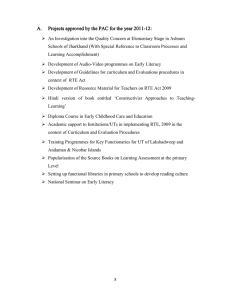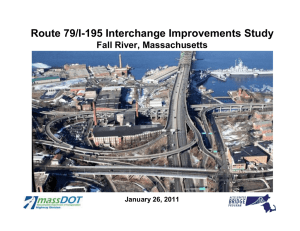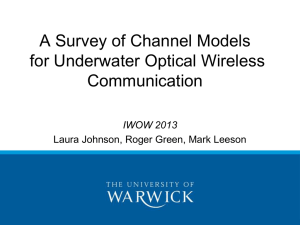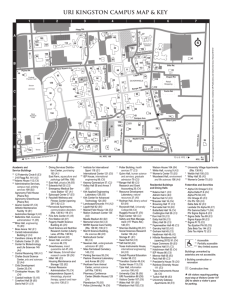Meeting Summary Rte. 79/I-195 Interchange Improvements Study
advertisement
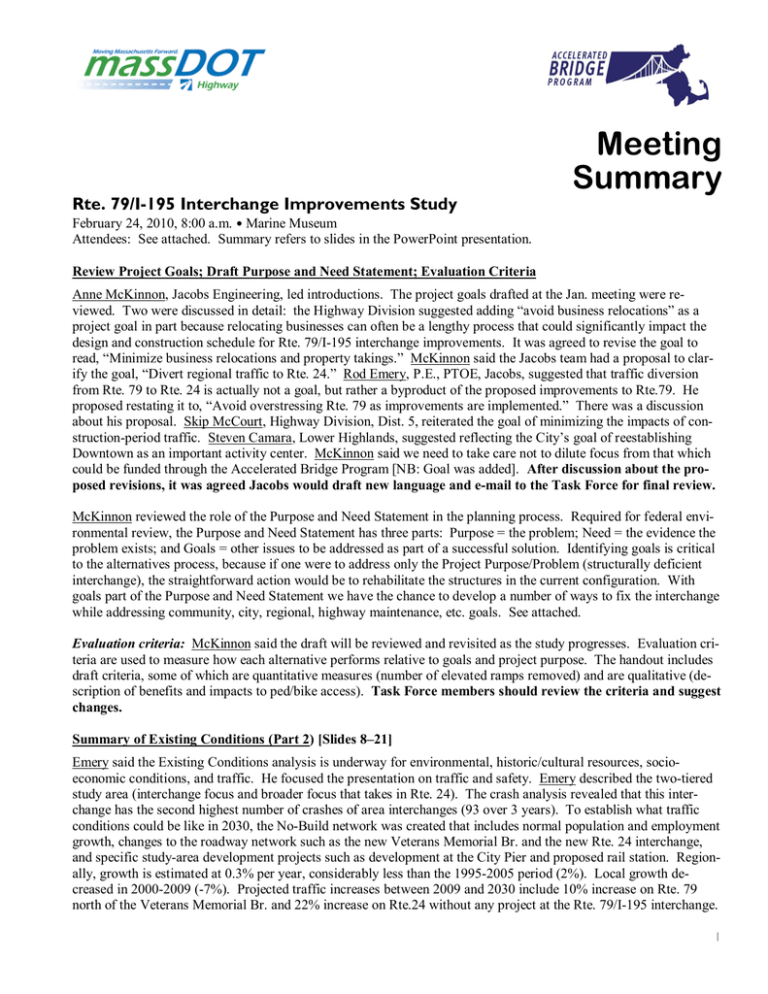
Rte. 79/I-195 Interchange Improvements Study Meeting Summary February 24, 2010, 8:00 a.m. Marine Museum Attendees: See attached. Summary refers to slides in the PowerPoint presentation. Review Project Goals; Draft Purpose and Need Statement; Evaluation Criteria Anne McKinnon, Jacobs Engineering, led introductions. The project goals drafted at the Jan. meeting were reviewed. Two were discussed in detail: the Highway Division suggested adding “avoid business relocations” as a project goal in part because relocating businesses can often be a lengthy process that could significantly impact the design and construction schedule for Rte. 79/I-195 interchange improvements. It was agreed to revise the goal to read, “Minimize business relocations and property takings.” McKinnon said the Jacobs team had a proposal to clarify the goal, “Divert regional traffic to Rte. 24.” Rod Emery, P.E., PTOE, Jacobs, suggested that traffic diversion from Rte. 79 to Rte. 24 is actually not a goal, but rather a byproduct of the proposed improvements to Rte.79. He proposed restating it to, “Avoid overstressing Rte. 79 as improvements are implemented.” There was a discussion about his proposal. Skip McCourt, Highway Division, Dist. 5, reiterated the goal of minimizing the impacts of construction-period traffic. Steven Camara, Lower Highlands, suggested reflecting the City’s goal of reestablishing Downtown as an important activity center. McKinnon said we need to take care not to dilute focus from that which could be funded through the Accelerated Bridge Program [NB: Goal was added]. After discussion about the proposed revisions, it was agreed Jacobs would draft new language and e-mail to the Task Force for final review. McKinnon reviewed the role of the Purpose and Need Statement in the planning process. Required for federal environmental review, the Purpose and Need Statement has three parts: Purpose = the problem; Need = the evidence the problem exists; and Goals = other issues to be addressed as part of a successful solution. Identifying goals is critical to the alternatives process, because if one were to address only the Project Purpose/Problem (structurally deficient interchange), the straightforward action would be to rehabilitate the structures in the current configuration. With goals part of the Purpose and Need Statement we have the chance to develop a number of ways to fix the interchange while addressing community, city, regional, highway maintenance, etc. goals. See attached. Evaluation criteria: McKinnon said the draft will be reviewed and revisited as the study progresses. Evaluation criteria are used to measure how each alternative performs relative to goals and project purpose. The handout includes draft criteria, some of which are quantitative measures (number of elevated ramps removed) and are qualitative (description of benefits and impacts to ped/bike access). Task Force members should review the criteria and suggest changes. Summary of Existing Conditions (Part 2) [Slides 8–21] Emery said the Existing Conditions analysis is underway for environmental, historic/cultural resources, socioeconomic conditions, and traffic. He focused the presentation on traffic and safety. Emery described the two-tiered study area (interchange focus and broader focus that takes in Rte. 24). The crash analysis revealed that this interchange has the second highest number of crashes of area interchanges (93 over 3 years). To establish what traffic conditions could be like in 2030, the No-Build network was created that includes normal population and employment growth, changes to the roadway network such as the new Veterans Memorial Br. and the new Rte. 24 interchange, and specific study-area development projects such as development at the City Pier and proposed rail station. Regionally, growth is estimated at 0.3% per year, considerably less than the 1995-2005 period (2%). Local growth decreased in 2000-2009 (-7%). Projected traffic increases between 2009 and 2030 include 10% increase on Rte. 79 north of the Veterans Memorial Br. and 22% increase on Rte.24 without any project at the Rte. 79/I-195 interchange. 1 Emery described the critical traffic movements at the Rte. 79/I-195 interchange that will need to be accommodated in any interchange reconfiguration: Close to 39,000 vehicles per day (vpd) use Rte. 79 NB and SB Rte. 79 SB and Broadway Ext. NB to I-195—approx. 20,000 vpd Rte. 79 SB—approx. 12, 300 vpd I-195 EB to Rte. 79 NB—approx. 10,500 vpd Local traffic to Rte. 79 NB—approx. 8,500 vpd Emery said the next steps in the traffic analysis will include finalizing the No-Build traffic projections (what traffic conditions would be like if the interchange were rehabilitated only) and then estimating the affects of the reconfiguration alternatives on traffic at the interchange, on Rte. 79 north, Rte. 24, and local streets. Ken Fiola, Fall River OED, requested a timeline and schedule for this study so he knows when he will be able to review the No-Build and Build analyses. Emery said the technical memorandum on existing conditions will be available for Task Force review in the near future, and the Task Force will identify a recommended alternative by the end of June. Fiola asked why existing Rte. 24/Rte. 79 crash data weren’t examined. Emery said the interchange is outside the detailed study area, which is focused on the Rte. 79/I-195 interchange. The team will analyze the data. Fiola asked if the complexity of the project warrants preparing an Environmental Impact Report (EIR). Michael O’Dowd, project manager for the Accelerated Bridge Program, said we won’t know how complex the environmental issues are until an alternative is developed and analyzed. Rep. David Sullivan asked for clarification: would preparing an EIR blow the schedule, eliminating the possibility of reconfiguring the interchange, leaving only the rehabilitation alternative that would leave the viaduct in place? O’Dowd said yes. McKinnon said the process and product will be comprehensive, in accordance with regulations, and focused and efficient so as not to miss an opportunity to use ABP funding. Ken Coehlo, FHWA, suggested the team provide a summary of the federal, state, and MassDOT environmental review processes to the Task Force to help clarify terms, schedule requirements, and practices that will come into play here. McKinnon said a schedule of milestones for the study will be prepared for the Task Force along with an environmental review “cheat sheet.” Conceptual Alternatives: Introduction [Slides 24–39] Emery described the purpose of the conceptual alternatives development and screening exercise. To ensure a range of solutions are examined, we generate a large number of ideas that address the project purpose and goals. Screening the conceptual alternatives is done to eliminate infeasible concepts, those that cannot be engineered reasonably or aren’t consistent with policies, leaving promising alternatives for the detailed alternatives analysis. Emery said the team developed 12 conceptual alternatives using basic goals identified by Task Force. Three basic reconfiguration alternatives “families” were developed along with one rehabilitation alternative: 1. Eliminate all “spaghetti ramps” and Rte. 79 viaduct 2. Eliminate some “spaghetti ramps” and Rte. 79 viaduct 3. Introduce collector-distributor system and eliminate Rte. 79 viaduct Emery described the alternatives, some of which address the goals of removing ramps but fail to meet many of the other goals identified by the Task Force. Several of the conceptual alternatives would essentially remove ramps from one location and replace them nearby. Alan Macomber requested an alternative that added direct ramp connections to Milliken Blvd., not the local street connections shown on several alternatives. Yes. Next steps: Emery said many of the 12 alternatives shown do not “work” for a number of reasons (traffic, constructability, fail to meet community goals, etc.) and should be “screened” or separated from those alternatives that will be retained for detailed analysis. This will be the activity at the next Task Force meeting, a 2 ½-hour work session devoted to reviewing and screening the alternatives to eliminate those failing key criteria. Materials will be sent to Task Force members in advance, and the work session will be held at the Museum or other space suitable for group discussion. The meeting adjourned at 9:44 a.m. The next meeting was tentatively set for Tues., Mar. 23, 8:00 a.m.–10:30 a.m. 2 Rte. 79/I-195 Interchange Study Attendees, February 24, 2010 Task Force meeting, 8:00 a.m. Marine Museum Attendees Rep. Kevin Alan Pedro Bob Stephanie Ethan Steven Jack Everett Ken Darren Daniel Rod Liz Amos Ken Robert John Jim Jim Pam Mary Rodney Lanny Marc Chris Don Al Dennis Alan Frank Skip Anne Steve Paul Patrick Michael Chris James Brian Jim Ronald Carl Paul Rep. David Patricia Steve Aquiar Amaral Amaral Bogan Boundy Britland Camara Casey Castro Coelho Conboy Crovo Emery Dennehy Fernandes Fiola Gregory Grosvenor Hadfield Hartnett Haznar Hynes Jacques Johnson Landry Laudon Leighton Lima Luttrell Macomber Mahady McCourt McKinnon McLaughlin Mission Norton O’Dowd Paiva Paul Pearson Pimental Rheaume Sawejko Simister Sullivan Tod Torres State Representative FREE Task Force chair State Representative Rodrigues aide Borden & Remington MassDOT MassDOT Lower Highlands/Historic District N’hood Assn. Battleship Cove Green Futures FHWA Jacobs Engineering Group MassDOT Hwy. Division Dist. 5 Jacobs Engineering Group Fall River Environmental Affairs Officer Jacobs Engineering Group Fall River OED MassDOT Hwy. Division Dist. 5 Newport Collaborative Architects/FREE consultant SRPEDD Fall River Planning Director MassDOT Hwy. Division Dist. 5 MassDOT Hwy. Division, Environmental William Starck Architects Fall River Redevelopment Authority Fall River area Chamber of Commerce Fall River mill owner and FREE Task Force Gates, Leighton & Assoc./FREE consultant Greater Fall River Land Conservancy Somerset Town Administrator Flanagan Transition Team FXM Associates (Jacobs team) MassDOT Hwy. Division Dist. 5 Jacobs Engineering Group MassDOT Hwy. Division SRPEDD US Congressman Jim McGovern aide MassDOT Hwy. Division Manufacturers Realty DCR, Heritage State Park resident S.E. Mass. Building Trades Carpenters Union Battleship Cove Marine Museum & Friends of Heritage State Park State House of Representatives Fall River mill owner Fall River Corporation Counsel 3 Rte. 79/I-195 Interchange Study Draft Purpose and Need Statement Purpose The purpose of the project is to address structural deficiencies at the Rte. 79/I-195 Interchange. Need The need is demonstrated by the poor condition of the viaduct and the number of bridges classified as structurally deficient. Chapter X provides details on the condition of the bridges at the interchange. Goals The project goals include: improve multi-modal (pedestrian, bicycle, etc.) access; reduce maintenance costs; improve the visual appearance of waterfront, etc.—all goals previously identified. 2/24/10 4
